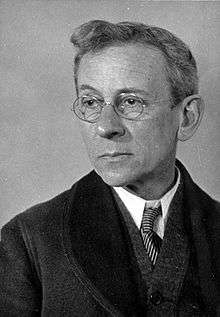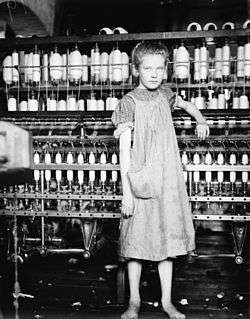Lewis Hine
| Lewis Hine | |
|---|---|
 | |
| Born |
Lewis Wickes Hine September 26, 1874 Oshkosh, Wisconsin |
| Died |
November 3, 1940 (aged 66) Hastings-on-Hudson, New York |
| Nationality | American |
| Education | University of Chicago, Columbia University, New York University |
| Known for | Social reform |
| Movement | Documentary; social realism |
| Patron(s) |
Russell Sage Foundation National Child Labor Committee Works Projects Administration |
Lewis Wickes Hine (September 26, 1874 – November 3, 1940) was an American sociologist and photographer. Hine used his camera as a tool for social reform. His photographs were instrumental in changing child labor laws in the United States.[1]
Early life
Hine was born in Oshkosh, Wisconsin, on September 26, 1874. After his father was killed in an accident, Hine began working and saved his money for a college education. He studied sociology at the University of Chicago, Columbia University and New York University. He became a teacher in New York City at the Ethical Culture School, where he encouraged his students to use photography as an educational medium.[2]

Hine led his sociology classes to Ellis Island in New York Harbor, photographing the thousands of immigrants who arrived each day. Between 1904 and 1909, Hine took over 200 plates (photographs) and came to the realization that documentary photography could be employed as a tool for social change and reform.[1]
Documentary photography
In 1907, Hine became the staff photographer of the Russell Sage Foundation; he photographed life in the steel-making districts and people of Pittsburgh, Pennsylvania, for the influential sociological study called The Pittsburgh Survey.


In 1908 Hine became the photographer for the National Child Labor Committee (NCLC), leaving his teaching position. Over the next decade, Hine documented child labor, with focus on the use of child labor in the Carolina Piedmont,[3] to aid the NCLC's lobbying efforts to end the practice.[4] In 1913, he documented child laborers among cotton mill workers with a series of Francis Galton's composite portraits.
Hine's work for the NCLC was often dangerous. As a photographer, he was frequently threatened with violence or even death by factory police and foremen. At the time, the immorality of child labor was meant to be hidden from the public. Photography was not only prohibited but also posed a serious threat to the industry. To gain entry to the mills, mines and factories, Hine was forced to assume many guises. At times he was a fire inspector, postcard vendor, bible salesman, or even an industrial photographer making a record of factory machinery.[5]
During and after World War I, he photographed American Red Cross relief work in Europe. In the 1920s and early 1930s, Hine made a series of "work portraits," which emphasized the human contribution to modern industry. In 1930, Hine was commissioned to document the construction of the Empire State Building. He photographed the workers in precarious positions while they secured the steel framework of the structure, taking many of the same risks that the workers endured. In order to obtain the best vantage points, Hine was swung out in a specially-designed basket 1,000 ft above Fifth Avenue.[6]

During the Great Depression Hine again worked for the Red Cross, photographing drought relief in the American South, and for the Tennessee Valley Authority (TVA), documenting life in the mountains of eastern Tennessee. He also served as chief photographer for the Works Progress Administration's National Research Project, which studied changes in industry and their effect on employment. Hine was also a faculty member of the Ethical Culture Fieldston School.
Later life
In 1936, Hine was selected as the photographer for the National Research Project of the Works Projects Administration, but his work there was not completed.
The last years of his life were filled with professional struggles by loss of government and corporate patronage. Few people were interested in his work, past or present, and Hine lost his house and applied for welfare. He died on November 3, 1940 at Dobbs Ferry Hospital in Dobbs Ferry, New York, after an operation.He was 66 years old[7]
Legacy
After Hine's death, his son Corydon donated his prints and negatives to the Photo League, which was dismantled in 1951. The Museum of Modern Art was offered his pictures and did not accept them, but the George Eastman House did.[8]
The Library of Congress holds over 5,000 Hine photographs, including examples of his child labor and Red Cross photographs, his work portraits, and his WPA and TVA images. Other large institutional collections include nearly ten thousand of Hine's photographs and negatives held at the George Eastman House and almost five thousand NCLC photographs at the Albin O. Kuhn Library & Gallery of the University of Maryland, Baltimore County.[9]
In 2006, author Elizabeth Winthrop Alsop's historical fiction middle-grade novel, Counting on Grace was published by Wendy Lamb Books. The latter chapters center on 12-year-old Grace and her life-changing encounter with photographer Lewis Hine, during his 1910 visit to a Vermont cotton mill known to have many child laborers. On the cover is the iconic photo of Grace's real-life counterpart, Addie Card[10] (1887-1993), taken during Hine's undercover visit to the Pownal Cotton Mill.
In 2016, Time published colorized versions of several of Hine's photographs of child labor in the US.[11]
Notable photographs
- Child Labor: Girls in Factory
- Breaker Boys (1910)[12]
- Young Doffers in the Elk Cotton Mills (1910)[13]
- Steam Fitter (1920)
- Workers, Empire State Building (1931)
Gallery
 Baseball team composed mostly of child laborers from a glassmaking factory. Indiana (1908)
Baseball team composed mostly of child laborers from a glassmaking factory. Indiana (1908) Adolescent Girl, a Spinner, in a Carolina Cotton Mill (1908) Princeton University Art Museum
Adolescent Girl, a Spinner, in a Carolina Cotton Mill (1908) Princeton University Art Museum
 Raising the Mast, Empire State Building (1932)
Raising the Mast, Empire State Building (1932)
See also
- House Calls (2006 film), a documentary about physician and photographer Mark Nowaczynski, who was inspired by Hine to photograph elderly patients.[15]
References
- 1 2 Troncale, Anthony T. "About Lewis Wickes Hine". New York Public Library. Archived from the original on March 8, 2007. Retrieved May 22, 2007.
- ↑ Smith-Shank, Deborah L. (March 2003). "Lewis Hine and His Photo Stories: Visual Culture and Social Reform". Art Education. 56 (2): 33–37. ISSN 0004-3125. OCLC 96917501.
- ↑ "Spinner in Vivian Cotton Mills, Cherryville, N.C.: Been at it 2 years. Where will her good looks be in ten years?". World Digital Library. Retrieved February 11, 2013.
- ↑ The American Quarterly, 'Lewis Hine: From "Social" to "Interpretive" Photographer, Peter Axis
- ↑ Rosenblum, Walter. Foreword. America & Lewis Hine: Photographs 1904-1940:. Comp. Marvin Israel (1977). New York: Aperture, up. 9-15. Print.
- ↑ Troncale, Anthony T. "Facts about the Empire State Building". New York Public Library. Retrieved May 22, 2007.
- ↑ The New York Times; November 4, 1940; "Lewis W. Hine; Photographer Whose Pictures Showed Conditions in Factories", p. 19
- ↑ Goldberg, Vicki (September 13, 1998). "The new season / Photography: critic's choice; A Career That Moved From Man to Machine". The New York Times. Retrieved October 25, 2010.
- ↑ "Lewis Hine Collection".
- ↑ "Through the Mill".
- ↑ Dullaway, Sanna (January 29, 2016). "Colorized Photos of Child Laborers Bring Struggles of the Past to Life". Time. Archived from the original on February 6, 2016. Retrieved February 6, 2016.
- ↑ "Breaker Boys", Life
- ↑ Lewis Wickes Hine Young Doffers in the Elk Cotton Mills, Fayetteville, Tennessee, 1910 at The Jewish Museum
- ↑ "Addie Card: Search For An Amemic Little Spinner". Morningsonmaplestreet.com. Retrieved October 15, 2009.
- ↑ Brett-MacLean, Pamela (May 27, 2007). "The elderly patient: in situ". CMAJ. Canadian Medical Association. Retrieved April 7, 2009.
External links
| Wikimedia Commons has media related to Lewis Hine. |
- Photo of Lewis Hine
- Library of Congress NCLC Prints & Photographs
- NCLCC Selected Bibliography
- Dozens of high-resolution Hine photos with the original captions
- Lewis Hine Project: Nationally known project to locate and interview descendants of child laborers photographed by Hine
- Lewis Hine: Immigration & The Progressive Era
- YouTube Video: "United States Child Labor, 1908-1920: As Seen Through the Lens of Sociologist and Photographer Lewis W. Hine" on YouTube
- Lewis Hine, Selected Prints
- Further works about Hine (from WorldCat)
- Further works about Hine (from WorldCat), online material only
- Further works by Hine (from WorldCat)
- Further works by Hine (from WorldCat), online material only
- The Center for Creative Photography at the University of Arizona has released a digital catalog of Hine's photograph collection.
- La Crosse Public Library Holding of booklet 'Lewis W. Hine, 1874-1940—A Biographical Essay, with Photographs by Lewis Wickes Hine: Courage to Love and Reform via Documentary Photography', researched, written, and authored by David Joseph Marcou, and first published by DigiCOPY of La Crosse, WI, in May 2014.